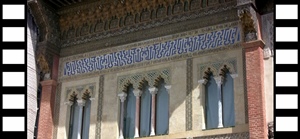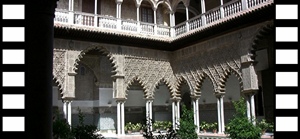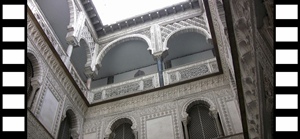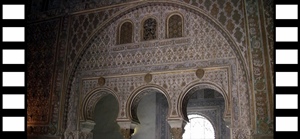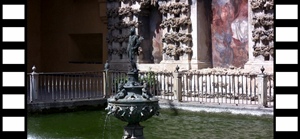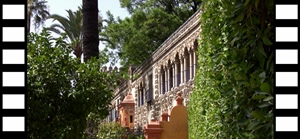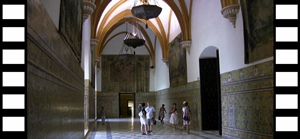After Al-Andalus, the Muslim portion of the Iberian Peninsula (the source of the
present-day name for the south of Spain, Andalusia) broke up into multiple kingdoms
in the 11th Century, Seville emerged as the most powerful city in the area. This
being the case, a combination fortress/palace known as
the Alcazar was built.
It underwent expansion and decoration over the years, and as a palace it probably
worked pretty well. But as a fortress it was less successful, being unable to keep
the Christians out, with the city falling to them in 1248. Eager to put their own
stamp on the place, the new Christian rulers replaced or heavily renovated most of
the palace. The style among Christians of the time was Gothic, with its
characteristic lofty spaces and pointed arches, and a Gothic palace was built on
the Alcazar grounds. But the new rulers also found themselves drawn to the
elaborate Islamic workmanship found throughout Andalusia. In 1364 King Pedro I of
Castile hired some of the remaining Moorish designers to build another palace in a
new style, a merging of the Gothic and Islamic now known as mudejar.
Extensive gardens in the adjoining area were designed and redesigned over the
centuries, resulting in a partitioning into areas with contrasting styles. Along
with the nearby Cathedral and Archivo de Indias (home to numerous documents
related to Spanish involvement in the New World), the Alcazar is designated a
UNESCO World Heritage Site.
The entrance to the Alcazar grounds is across the Plaza del Triunfo from the
Cathedral, through a portal on the right. This portal is called the Lion Gateway,
named for a panel of tiles above it depicting a lion with a crown and cross (added
in 1894).

The Lion Gateway (Puerta del León)
We entered through the Gateway, paid our money (7.50 Euros apiece) and passed
through a courtyard called the Lion's Courtyard into another courtyard, called
the Hunting Courtyard. This gave us a view of what is probably the architectural
highlight of the complex, the Palace of Pedro I.

Palace of Pedro I

Palace of Pedro I
King Pedro, also known as Pedro the Cruel (he apparently dealt with rivals
by having them assassinated), had the palace built over a period of just two
years, with completion in 1366. The building replaced a Moorish one on the
same site, which he had demolished. But he didn't get a chance to enjoy the
new palace much, as he himself was personally assassinated by his
half-brother Henry in 1369, at the age of 34. But the palace was much
enjoyed by ensuing royal families, and the upper floor remains a royal
residence to the present day.
We entered the palace and looked around, finding it to consist mainly of
smallish rooms surrounding a courtyard with a long reflecting pool, called
the Maidens' Patio. This courtyard has found its way into the movies,
appearing in Ridley Scott's Kingdom of Heaven in 2005. There is
another small courtyard in the palace, called the Dolls' Patio, and the
remainder of the ground floor seems to consist of a succession of connected
rooms. The workmanship is gorgeous throughout.

Calligraphy, Palace Vestibule

Archway, Palace Vestibule
The Maidens' Patio (Patio de las Doncellas)

The Maidens' Patio

The Maidens' Patio

Passageway Toward Dolls' Patio

The Dolls' Patio (Patio de las Muñecas)

The Dolls' Patio

The Ambassadors' Hall (Salón de los Embajadores)

Ceiling, the Ambassadors' Hall

The East Room

Corner of Room

Archway

Window

Window, Side Room to Infantes' Rooms
Behind Pedro's Palace is a large area occupied by gardens of various styles, some
large, some small and some compartmentalized. Closest to the palace are gardens
of Mannerist style (a style that succeeded the high Renaissance), planned by the
architect Vermondo Resta early in the 17th Century. These are the smallest and
most compartmentalized of the gardens.
Charles V Bust, Flower Garden

Doorway, Flower Garden

Arches, Garden of Troy (Jardín de Troya)

Palm Tree

Fountain, Dance Garden (Jardín de la Danza)

Grotto Gallery and Estanque de Mercurio

Estanque de Mercurio and Grotto Gallery
A little farther from the palace is the larger Damsels' garden (named for statues
of goddesses which have disappeared in the years since the garden was named), also
laid out by Resta. This garden is centered on a fountain featuring a statue of
Neptune.

Nella and Neptune's Fountain, Damsels' Garden

Neptune's Fountain, Damsels' Garden
The Grotto Gallery
Bordering the Damsels' Garden is a long wall called the Grotto Gallery. This
525-foot-long wall contains a covered walkway that separates the Mannerist
gardens from some larger gardens, including the 19th-Century English-style
Poets' Garden. We gave the Poets' Garden a quick look and returned to the
Damsels' Garden.

The Grotto Gallery (Galería del Grutesco)

The Grotto Gallery

Bob, Poets' Garden

Poets' Garden

Peacock, Poets' Garden

Nella in Poets' Garden

Fountain, Poets' Garden

Return to the Damsels' Garden
Neptune's Fountain, Lantern of Tapestry Room
Reachable through a tunnel off the Dance Garden are the María Padilla Baths, a
roofed-over pool which is said to have been a favorite spot of Pedro I's mistress,
María Padilla. The story of María Padilla is that Pedro took a fancy to her and
had her husband killed, and Ms. Padilla disfigured herself with boiling oil to
repulse Pedro's advances. María ended up in a convent and is a symbol of Sevillian
purity.
María Padilla Baths (Los Baños de Doña María de Padilla)
From the gardens we entered the Gothic Palace, which also borders them. This
palace, though interesting, is not nearly as distinctive as Pedro's Palace. It
contains a room of elaborate tapestries.
Urn, Gothic Palace

Door and Allegorical Tiles, Vault Room

Vault Room

Battle Scene, Tapestry Room

Charles V's Campaign Against Tunisia
After leaving the Gothic Palace we did some wandering and found ourselves back
in the Hunting Courtyard. We walked over to the building to the right of Pedro's
Palace and found ourselves in the Admiral's Quarters, a room where a number of
expeditions to the New World were planned. There was an adjoining chapel to this
room, no doubt used on occasion to solicit divine assistance to the success of
the expeditions.

Virgin of the Mariners (1535)

Altarpiece with Virgin of Antigua (18th C.)
Model of Santa María
Further wanderings found us displays of splendid fans and tiles. Fans are used
in Spain as instruments of concealment and flirtation, and of course to help
keep one cool in the Spanish heat. Tiles are used extensively in Spanish
architecture, particularly in Andalusia.

Fans (French)

Fan

Tiles

Tiles
We exited the Alcazar grounds through a doorway that dumped us back out into the
Plaza del Triunfo, where we had a nice view of the Cathedral.

Cathedral Through Archway

The Giralda
By this time it was well past 5:30, but since this was summer, there was still
plenty of daylight to be had. We struck out for the city's Museum of Fine Art
on the far side of the old town – it was open until 7:30, and wasting all that
daylight would have been shameful.



